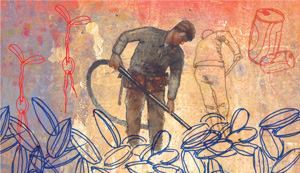“Robb, make sure you dump all the trash and run the shop vacuum in the entry before you leave,” general contractor Tom Phelps reminded his finish carpentry foreman. “Now that we’re on the closing end of the project, I want to keep our tidiness on track.” Remembering his boss’ nickname in high school, Robb smiled as he proceeded with his cleanup and lockup duties, thinking to himself, “He really is Suzy Homemaker.”
The Clancey project was going great. The 3,876-square-foot house had high-end finishes and a three-car garage, along with an 800-square-foot outbuilding designed to function as a home office/art studio. The time investment in the project had been substantial: nine months of design, an additional 12 weeks of permitting, and then time in front of the design review board. Torrential rains that fall added an extra two and a half months to the excavation and site-grading phase.
Tom had often mentally compared the muddy conditions of the Clancey project to the film footage he had seen on The History Channel of American troops marching and fighting in winter mud and slush conditions throughout Europe during World War II. “At least nobody’s shooting at us,” he’d muse.
As if dealing with the conditions on site weren’t enough, Phelps Custom Homes also had to bear the burden of mud-removal costs and remediation to the street areas affected by the entry and departure of trucks and heavy equipment. By the time “mud season” ended, Tom’s company had spent nearly $9,000 keeping the public roadways free of mud and site debris. “Never had that in the budget,” he often reminded himself.
Tom had met Bill and Jan Clancey more than two years ago, while working on another custom home. It was a Saturday afternoon. The Clanceys were driving through the neighborhood looking at homes and lots when they stumbled upon the Hatfield project.
As they got out of their car and approached the home, they heard a high-pitched sound. It grew dramatically louder as they entered the structure. “Excuse me?” Bill yelled repeatedly, trying to get the noisemaker’s attention. Finally, Tom heard Bill’s voice and shut off his shop vac. “Sorry, I can’t hear anything with my earplugs in,” Tom said as he introduced himself. He and the Clanceys got to talking, and though he didn’t know it at the time, Tom had just landed another custom home client.
“I’ve been sweeping out the stud cavities, getting ready for my insulation sub, who will be here first thing Monday morning,” Tom told the Clanceys. “We don’t want to leave wood chips, dirt, or debris in any area that will be filled with insulation, because sawdust and dirt can act as a nesting ground for insects and rodents. I’m here because my superintendent had his boys’ soccer tournament in San Antonio this weekend. Normally, he does this kind of work.”
Tom left quite an impression on the Clanceys, as it turned out. They had been looking for a contractor for quite some time, but hadn’t bonded with anyone like they had after just a few minutes spent with him. He was easy to talk to. They’d seen his name around town, and lo and behold, he was on one of his project sites on a Saturday. Jan was immediately impressed with the cleanliness of the jobsite and the simple fact that Phelps Custom Homes was taking the time to actually clean the stud cavities prior to insulation.
The takeaway message from this initial encounter? People buy for simple reasons. For the Clanceys, Phelps Custom Homes offered a level of trust and care they hadn’t seen from anyone else. As it turned out, jobsite cleanliness was Jan Clancey’s hot button.
Turning Point. After nine months of hard work, Phelps Custom Homes still had three weeks of a tight completion schedule remaining to finish the Clancey project on time. Doing so was of paramount importance not only to his clients, but to Tom as well. Finishing on time—and with a satisfied client—would result in a $15,000 bonus payable to his company. “I could really use that money to help defray those extraneous mud expenses incurred at the beginning of the job,” Tom thought to himself. It was something he’d considered numerous times throughout the project. The odds were with him. Things were going great.



